Automotive Spare Parts Management: A Critical Aspect of After-Sales Processes
- February 14
- 18 min

Automated fleet management is the use of advanced technology, artificial intelligence, and cloud-based software to streamline, monitor, and optimize fleet operations without manual intervention. This comprehensive approach transforms traditional vehicle management by automating routine tasks, improving decision-making through real-time data, and reducing operational costs across all aspects of fleet operations.
Modern businesses face increasing pressure to reduce costs, improve efficiency, and meet evolving customer expectations. This guide explores how automated fleet management systems revolutionize vehicle operations, from small delivery services to large enterprise fleets, by leveraging cutting-edge technology to automate workflows and optimize performance.
Key Takeaways:
Fleet management encompasses the complete oversight of commercial vehicles, from acquisition to disposal. This process involves coordinating multiple aspects of vehicle operations to maximize efficiency while minimizing costs.
Traditional fleet management requires extensive manual coordination. Fleet managers track vehicle locations using phone calls or radio communication. Maintenance schedules rely on calendar-based intervals rather than actual vehicle condition. Route planning happens manually, often without considering real-time traffic or delivery constraints.
These manual processes create inefficiencies and missed opportunities. Vehicle utilization remains suboptimal when managers lack real-time visibility. Maintenance costs escalate when repairs happen reactively rather than preventively. Customer satisfaction suffers when delivery estimates prove inaccurate.
Understanding traditional fleet management components helps illustrate how automation transforms these processes.
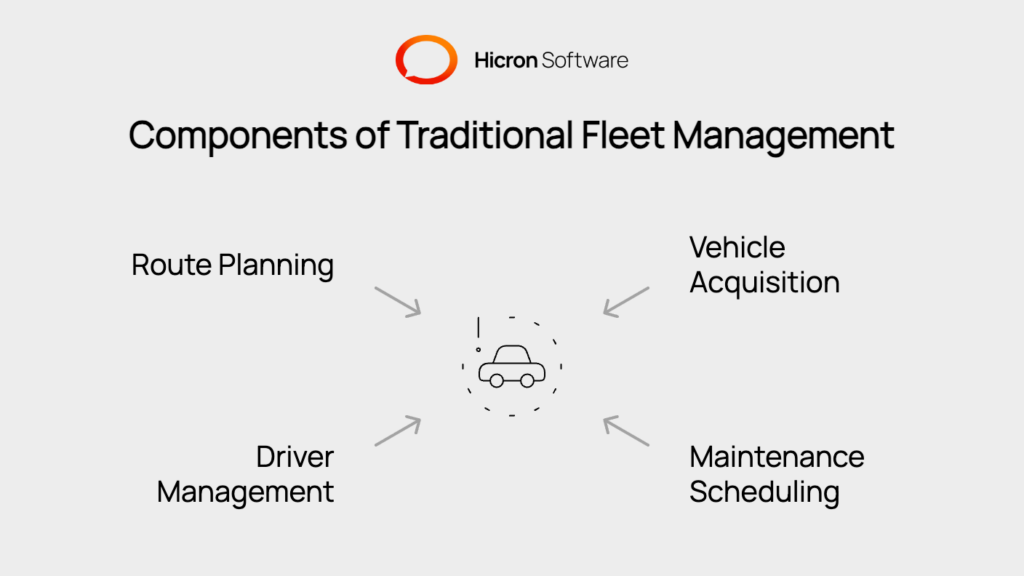
Fleet managers traditionally research vehicle options manually, comparing specifications and pricing across multiple dealers. Purchase decisions rely on historical data rather than predictive analytics. Vehicle disposal timing depends on general guidelines rather than actual condition assessments.
Conventional maintenance follows manufacturer recommendations based on time or mileage intervals. Managers schedule service appointments manually, often resulting in unnecessary maintenance or missed preventive care. Emergency repairs happen reactively, causing unexpected downtime and higher costs.
Traditional driver management involves manual performance reviews and training programs. Safety monitoring relies on accident reports rather than ongoing behavior analysis. Compliance tracking requires extensive paperwork and manual record-keeping.
Manual route planning considers basic factors like distance and delivery windows. Traffic conditions, weather impacts, and vehicle capacity often receive insufficient attention. Dynamic changes during operations require radio communication and manual coordination.
Traditional methods create numerous operational challenges that automation addresses effectively.
Manual processes introduce human error and inconsistency. Data collection happens sporadically, limiting visibility into fleet performance. Communication between drivers, dispatchers, and managers often proves inefficient. Compliance monitoring requires extensive documentation and manual verification.
These challenges compound as fleet size increases. Managing ten vehicles manually might work, but coordinating hundreds becomes overwhelming. Scaling operations without automation leads to increased administrative overhead and reduced efficiency.
Cost control becomes difficult without real-time data and automated optimization. Fuel expenses, maintenance costs, and labor productivity remain hard to track and improve without systematic measurement and analysis.
Fleet management software digitizes and automates traditional fleet operations. These platforms integrate multiple technologies to provide comprehensive vehicle oversight and control.
Modern fleet management software addresses traditional challenges through real-time data collection, automated workflows, and predictive analytics. Cloud-based platforms ensure accessibility from any location while providing scalable solutions for growing businesses.
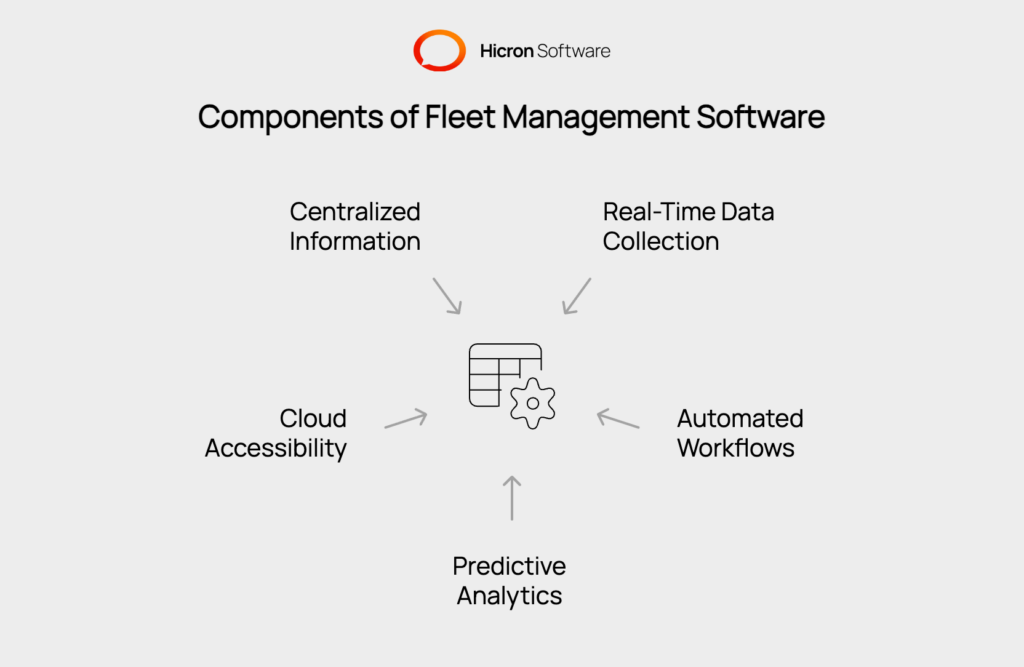
The software serves as a central hub for all fleet-related information. Vehicle locations, maintenance records, driver performance data, and operational metrics become accessible through a single interface. This centralization eliminates information silos and improves coordination across all stakeholders.
Automated fleet management systems provide comprehensive functionality that transforms how fleets operate.
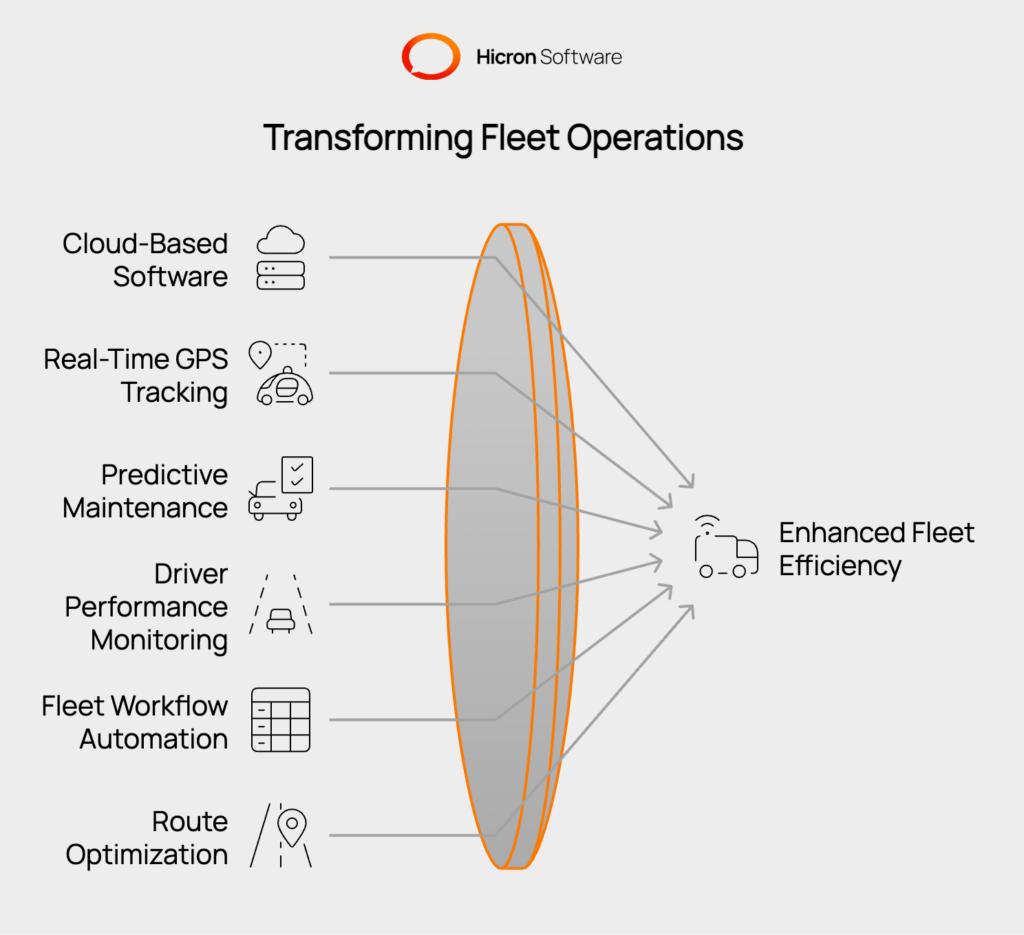
Cloud technology provides the foundation for modern fleet automation. These platforms store data centrally while providing access from any internet-connected device. Real-time synchronization ensures all users work with current information.
Cloud-based solutions offer scalability that traditional software cannot match. Adding vehicles or users requires no additional hardware installation. Automatic updates ensure access to the latest features without manual intervention.
Data security improves through professional cloud infrastructure. Regular backups prevent data loss while encryption protects sensitive information. Professional IT management reduces the burden on fleet operations teams.
GPS technology provides precise vehicle location data updated continuously. Fleet managers monitor vehicle positions, routes, and speeds in real-time. This visibility enables immediate response to emergencies or operational changes.
Advanced tracking systems include geofencing capabilities. Virtual boundaries around specific locations trigger automatic alerts when vehicles enter or exit designated areas. This functionality supports customer billing, security monitoring, and compliance verification.
Historical tracking data reveals patterns in vehicle usage and route efficiency. Analysis of this information identifies optimization opportunities and supports strategic planning decisions.
Automated maintenance systems monitor vehicle condition through telematics and diagnostic data.
trigger maintenance alerts before problems develop.
Predictive algorithms analyze usage patterns and component lifecycles to optimize maintenance timing. This approach prevents unnecessary service while ensuring critical maintenance happens promptly. Maintenance costs decrease while vehicle reliability improves.
Integration with service providers streamlines maintenance scheduling and tracking. Automated appointment booking and status updates reduce administrative overhead while ensuring proper vehicle care.
Automated fleet management systems track driving behaviors including acceleration, braking, cornering, and speed compliance. This data identifies training opportunities and recognizes exceptional performance. Safety improvements result from ongoing monitoring and feedback.
Hours of service compliance automation reduces regulatory violations and associated penalties. Electronic logging eliminates manual record-keeping while ensuring accurate documentation. Driver fatigue monitoring enhances safety through automated rest period tracking.
Performance analytics compares drivers across multiple metrics, enabling targeted training programs. Recognition programs based on objective data improve driver retention and safety culture.
Automated dispatching assigns jobs based on vehicle location, capacity, and driver availability. This optimization reduces response times while maximizing resource utilization. Customer service improves through faster, more reliable service delivery.
Automated reporting generates regular performance summaries without manual data compilation. Key performance indicators become visible through customizable dashboards. Management decisions improve through access to accurate, timely information.
Compliance automation ensures regulatory requirements are met consistently. Electronic records reduce paperwork while maintaining audit trails. Automated alerts prevent violations before they occur.
AI-powered route planning considers multiple variables simultaneously. Traffic conditions, delivery windows, vehicle capacity, and driver schedules influence optimal route selection. Real-time adjustments adapt to changing conditions throughout the day.
Dynamic routing responds to
Alternative routes minimize disruption while maintaining service quality. Fuel consumption decreases through optimized travel patterns.
Customer communication improves through automated arrival time updates. Real-time tracking enables proactive notification of delays or early arrivals. Customer satisfaction increases through improved reliability and communication.
Automation of the fleet management system delivers measurable improvements across multiple operational areas.
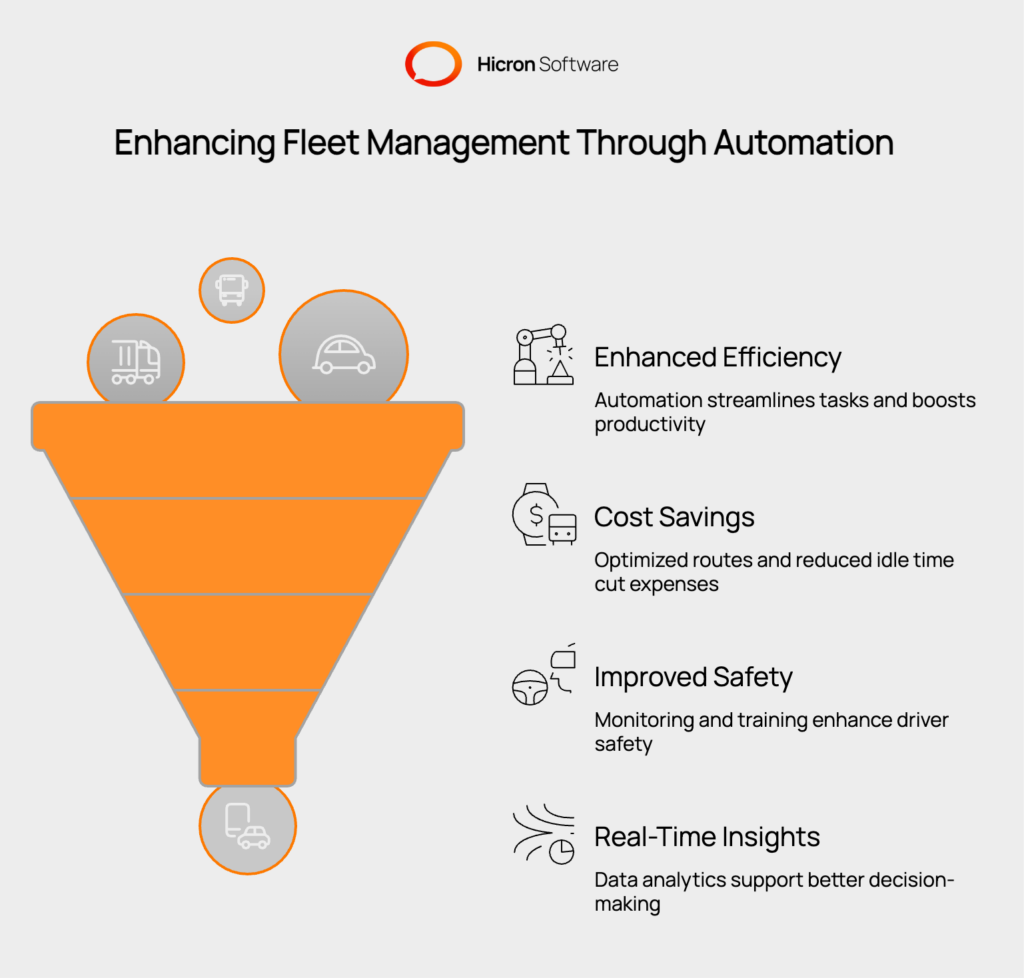
Automated systems handle routine tasks faster and more accurately than manual processes. Dispatching, scheduling, and reporting happen automatically, freeing staff for strategic activities. Overall productivity increases while administrative overhead decreases.
Resource utilization improves through optimization algorithms. Vehicles spend more time in productive use rather than idle. Driver productivity increases through efficient routing and automated job assignment.
Communication streamlines through integrated messaging systems. Information flows automatically between drivers, dispatchers, and customers. Response times improve while miscommunication decreases.
Fuel costs decrease through optimized routing and reduced idle time. Some organizations report fuel savings after implementing automated systems. Maintenance costs drop through predictive scheduling and component monitoring.
Administrative costs reduce through workflow automation. Manual data entry, report generation, and scheduling become automated processes. Staff can focus on higher-value activities rather than routine tasks.
Insurance costs may decrease through improved safety monitoring and driver training programs. Many insurers offer discounts for fleets using telematics and driver monitoring systems.
Continuous monitoring identifies unsafe driving behaviors immediately. Coaching opportunities emerge from objective performance data rather than subjective observations. Accident rates decrease through proactive safety management.
Training programs become more targeted and effective through performance analytics. Drivers receive specific feedback about their performance rather than generic safety reminders. Motivation improves through recognition programs based on measurable achievements.
Compliance improves through automated monitoring and reporting. Violations decrease when systems prevent regulatory breaches before they occur. Driver satisfaction often improves when compliance becomes easier to maintain.
Dashboard analytics provide immediate visibility into fleet performance. Key metrics like
become constantly available. Management decisions improve through access to current, accurate data.
Trend analysis identifies patterns that manual processes might miss.
become visible through automated data collection and analysis.
Predictive analytics support strategic planning decisions.
become clearer through comprehensive data analysis.
Different industries benefit from automation in unique ways, though core principles remain consistent across applications. This table organizes the use cases for automated fleet management across various industries into a clear and actionable format.
|
Industry |
Use Cases |
|
Delivery and Logistics |
|
|
Field Services |
|
|
Construction Fleets |
|
|
Corporate Fleets |
|
|
Public Sector Fleets |
|
E-commerce growth drives demand for efficient last-mile delivery. Automated systems optimize delivery routes while providing customers with accurate tracking information. Real-time adjustments accommodate traffic delays or address changes.
Package delivery services use automation to sequence stops for maximum efficiency. Customer notification systems provide delivery windows and track packages in real-time. Driver productivity increases through optimized routes and automated navigation.
Food delivery operations benefit from real-time tracking and temperature monitoring. Automated systems ensure food safety compliance while optimizing delivery times. Customer satisfaction improves through accurate delivery predictions and proactive communication.
Service technicians require efficient routing between customer locations. Automated scheduling considers technician skills, location, and availability when assigning jobs. Customer service improves through accurate appointment scheduling and arrival predictions.
Emergency services use automation for rapid response coordination. Automated dispatching identifies the closest available unit while considering traffic conditions. Response times decrease through optimized routing and real-time navigation.
Maintenance services benefit from predictive scheduling and inventory management. Automated systems track parts usage and schedule preventive maintenance visits. Customer relationships improve through proactive service rather than reactive repairs.
Heavy equipment requires specialized monitoring for location, utilization, and maintenance needs. Automated systems track equipment across multiple job sites while monitoring performance metrics. Theft prevention improves through geofencing and unauthorized use alerts.
Material delivery coordination becomes more efficient through automated scheduling. Concrete trucks, excavators, and support vehicles coordinate automatically to minimize waiting time. Project timelines improve through better resource coordination.
Equipment maintenance automation prevents costly breakdowns. Heavy machinery operates in demanding conditions that require careful monitoring. Predictive maintenance systems prevent failures that could halt entire projects.
Company car programs benefit from automated expense tracking and policy enforcement. Mileage logging, fuel card integration, and maintenance scheduling happen automatically. Administrative overhead decreases while policy compliance improves.
Employee transportation services use automation for route optimization and capacity management. Shuttle services, pool vehicles, and executive transportation coordinate efficiently through automated systems. Cost control improves through detailed usage tracking and optimization.
Sales team vehicle management becomes more efficient through automated reporting. Territory coverage, customer visit tracking, and expense management integrate with CRM systems. Sales productivity improves through reduced administrative tasks.
Municipal vehicle fleets require accountability and cost control. Automated systems provide detailed usage tracking and performance metrics for public transparency. Maintenance costs decrease through predictive scheduling and vendor management.
Emergency services benefit from automated dispatch and resource coordination. Police, fire, and ambulance services coordinate more effectively through integrated communication systems. Public safety improves through faster response times and better resource allocation.
School transportation systems use automation for route optimization and safety monitoring. Student pickup and drop-off times improve through efficient routing. Safety increases through driver monitoring and vehicle tracking systems.
Successful implementation requires careful planning and systematic execution. This table organizes the steps for implementing an automated fleet management system into a clear and actionable format.
|
Step |
Description |
|
Assess Your Fleet’s Needs and Goals |
|
|
Choose or Develop the Right Cloud-Based Fleet Management Software |
|
|
Integrate Automation Tools with Existing Systems |
|
|
Train Your Team to Adapt to Automated Workflows |
|
|
Measure Success with KPIs |
|
Begin by documenting current operational challenges and inefficiencies. Identify specific problems that automation could address, such as high fuel costs, frequent breakdowns, or compliance issues. Quantify these challenges where possible to measure improvement later.
Define clear objectives for automation implementation. Cost reduction targets, efficiency improvements, and safety goals provide measurable success criteria. Stakeholder input ensures objectives align with business priorities and operational realities.
Evaluate current technology infrastructure and integration requirements. Existing systems for accounting, customer management, or maintenance may need integration with new fleet management platforms. Compatibility assessment prevents implementation delays and additional costs.
Research multiple software providers to understand available options and features. Request demonstrations that show how each system addresses your specific needs. Compare pricing models, implementation requirements, and ongoing support options.
Evaluate scalability to ensure the system grows with your business. Consider both vehicle capacity and feature expansion when making selection decisions. Long-term contracts require confidence in the provider’s ability to meet evolving needs.
Check integration capabilities with existing business systems. Accounting software, customer relationship management platforms, and maintenance systems may require data sharing. API availability and integration support vary significantly between providers.
Plan integration carefully to minimize business disruption. Data migration from existing systems requires verification and testing before going live. Backup procedures ensure recovery if integration problems develop.
Train technical staff on new integration processes and troubleshooting procedures. Complex integrations may require ongoing technical support and maintenance. Internal capability development reduces dependence on external vendors.
Test integrated systems thoroughly before full deployment. Data accuracy, workflow functionality, and performance requirements need verification across all connected systems. Gradual rollout identifies problems before they affect entire operations.
Develop comprehensive training programs for different user groups. Drivers, dispatchers, and managers require different training focused on their specific roles and responsibilities. Hands-on practice improves adoption rates and reduces resistance to change.
Address concerns about job security and technology complexity. Explain how automation enhances rather than replaces human capabilities. Emphasize benefits like reduced paperwork, better working conditions, and improved safety.
Provide ongoing support during the transition period. Questions and problems emerge as users become familiar with new processes. Quick resolution of issues prevents frustration and maintains momentum during implementation.
Establish baseline measurements before implementing automation. Fuel consumption, maintenance costs, delivery times, and safety incidents provide comparison points for measuring improvement. Historical data helps set realistic expectations for improvement.
Track key performance indicators regularly after implementation. Monthly reviews identify trends and areas needing attention. Continuous monitoring ensures problems receive prompt attention before they become major issues.
Adjust processes based on performance data and user feedback. Automation systems often require fine-tuning as operations adapt to new capabilities. Flexibility in approach ensures maximum benefit from technology investments.
Understanding potential obstacles helps prepare for successful implementation.
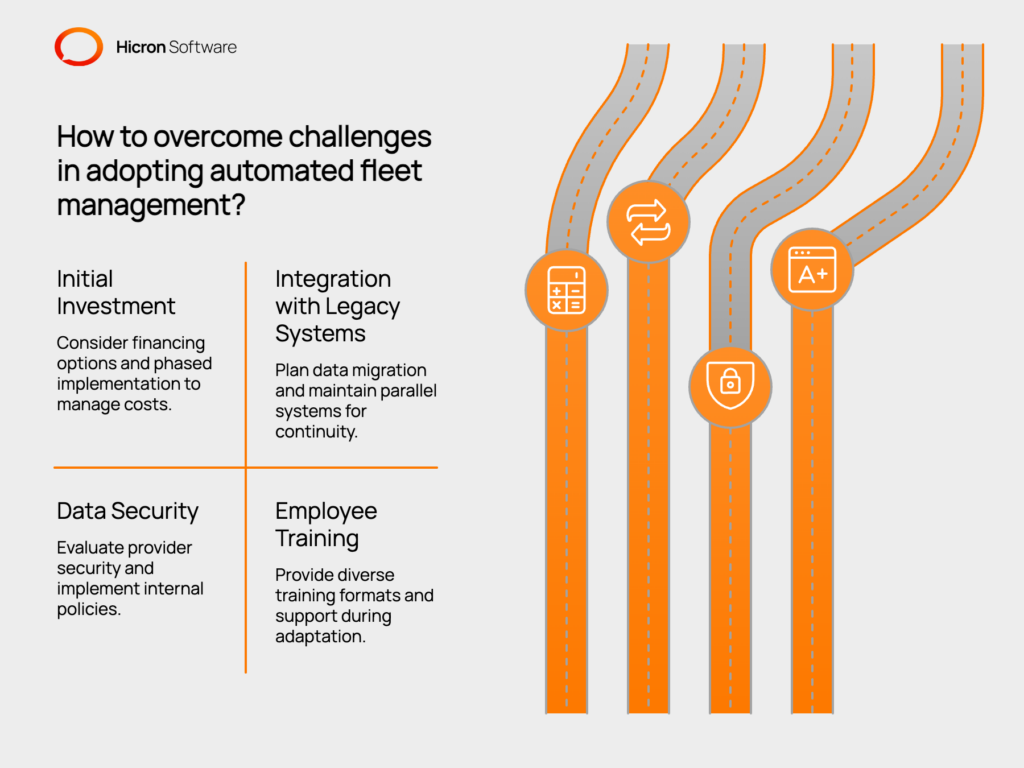
Automated fleet management requires upfront investment in software, hardware, and training. Vehicle telematics devices, mobile computers, and communication systems represent immediate costs. Software licensing and implementation services add to initial expenses.
Calculate return on investment carefully using realistic improvement estimates. Fuel savings, maintenance cost reductions, and productivity improvements offset initial costs over time. Conservative projections help ensure positive outcomes.
Consider financing options and phased implementation to manage cash flow. Some providers offer leasing arrangements or gradual rollout programs. Spreading costs over time makes adoption more manageable for smaller organizations.
Older computer systems may lack modern integration capabilities. Data formats, communication protocols, and security requirements can complicate connections with new fleet management platforms. Legacy system limitations may require expensive upgrades or replacements.
Plan data migration carefully to preserve historical information. Customer records, maintenance histories, and operational data provide valuable context for new systems. Data cleaning and verification ensure accuracy in the new environment.
Maintain parallel systems during transition periods to ensure business continuity. Gradual migration reduces risk while allowing thorough testing of new processes. Backup plans provide security if integration problems develop.
Cloud-based systems require trust in third-party security measures. Vehicle location data, driver information, and operational details need protection from unauthorized access. Evaluate provider security certifications and track records.
Understand data ownership and access policies. Some providers claim ownership of aggregated data or reserve rights to use information for product improvement. Legal review ensures acceptable terms and conditions.
Implement internal security policies for system access and data handling. User authentication, password management, and access controls protect sensitive information. Employee training ensures security policies receive proper implementation.
Technology adoption rates vary significantly among different age groups and experience levels. Some employees embrace new tools while others resist change. Training programs must accommodate different learning styles and comfort levels.
Provide multiple training formats, including hands-on practice, video tutorials, and written guides. Different people learn better through different methods. Comprehensive training resources ensure everyone can develop necessary skills.
Maintain patience during the learning curve period. Productivity may decrease temporarily as employees adapt to new processes. Support and encouragement during this period determine long-term adoption success.
Technology continues evolving, bringing new capabilities and opportunities.
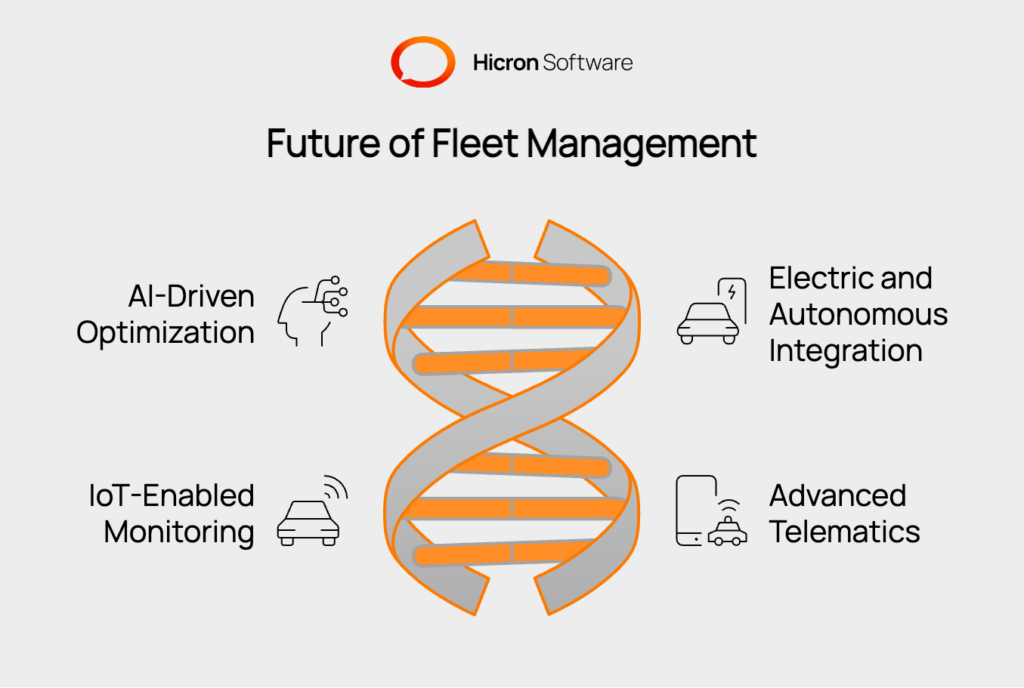
Artificial intelligence capabilities continue improving, enabling more sophisticated optimization algorithms. Machine learning systems analyze vast amounts of operational data to identify optimization opportunities that human analysis might miss.
Predictive analytics become more accurate as systems collect more data. Vehicle failure predictions, traffic pattern analysis, and customer demand forecasting improve over time. Better predictions enable more effective planning and resource allocation.
Integration with external data sources enhances optimization capabilities. Weather forecasts, traffic patterns, and economic indicators influence optimal fleet operations. AI systems incorporate these factors automatically into decision-making processes.
Electric vehicle adoption requires new management capabilities. Battery monitoring, charging station coordination, and range planning become critical fleet management functions. Automated fleet management systems adapt to address these new requirements.
Autonomous vehicle technology introduces new fleet management possibilities. Vehicle dispatching, routing, and utilization could become fully automated. Human oversight remains important, but routine operations may require minimal intervention.
Mixed fleets containing conventional, electric, and autonomous vehicles require sophisticated management systems. Different vehicle types have unique capabilities and requirements. Optimization algorithms must consider these differences when making operational decisions.
Internet of Things sensors provide detailed information about vehicle condition and cargo status. Temperature monitoring, vibration analysis, and air quality measurement enhance fleet management capabilities beyond basic location tracking.
Real-time data enables immediate response to problems. Refrigerated cargo temperature alerts, hazardous material monitoring, and security breach detection provide immediate notification of critical situations.
Predictive maintenance becomes more sophisticated with detailed sensor data. Component-level monitoring enables precise failure predictions and optimized replacement timing. Maintenance costs decrease while reliability improves.
Fifth-generation cellular networks provide faster data transmission and lower latency. Real-time communication between vehicles and management systems becomes more responsive. Advanced applications requiring immediate data exchange become practical.
Vehicle-to-vehicle communication enables coordination between fleet units. Traffic information sharing, convoy management, and collaborative route optimization become possible. Fleet efficiency improves through better coordination.
Enhanced bandwidth supports rich media communication. Video communication between drivers and dispatchers, real-time cargo monitoring, and advanced training delivery become practical. Communication quality improves across all fleet operations.
Automated fleet management represents a fundamental shift from reactive to proactive operations. Technology transforms traditional manual processes into intelligent, data-driven systems that optimize performance while reducing costs and improving safety.
The benefits extend beyond simple cost savings to include improved customer service, enhanced safety, and better strategic decision-making. Organizations implementing automated systems position themselves for competitive advantage in increasingly challenging markets.
Success requires careful planning, appropriate technology selection, customization, and commitment to change management. The investment in automation pays dividends through improved efficiency, reduced costs, and enhanced operational capabilities.
Consider your fleet’s specific needs and challenges when evaluating automation opportunities. Start with clear objectives, choose appropriate technology partners, and implement changes systematically. The future of fleet management is automated, and early adopters gain lasting competitive advantages. Get in touch to start automating your fleet.
Implementation typically takes 4-12 weeks depending on fleet size and system complexity. Small fleets with basic requirements can be operational within a month, while large enterprises with complex integrations may require several months for complete deployment.
Most organizations see cost reductions of 10-25% within the first year. Fuel savings of 10-20%, maintenance cost reductions of 15-30%, and administrative efficiency improvements contribute to overall cost reductions. Actual savings depend on current efficiency levels and implementation completeness.
Modern systems include offline capabilities that store data locally when connectivity is limited. Information synchronizes automatically when cellular coverage returns. Critical functions like GPS tracking and driver communication continue operating even with intermittent connectivity.
Basic system operation typically requires 2-4 hours of training for drivers and 8-16 hours for fleet managers. Advanced features and administrative functions may require additional training. Most providers offer comprehensive training programs as part of implementation services.
Reputable providers use enterprise-grade security including data encryption, access controls, and regular security audits. Cloud security often exceeds what individual organizations can implement independently. However, evaluate provider security certifications and policies before making selection decisions.
